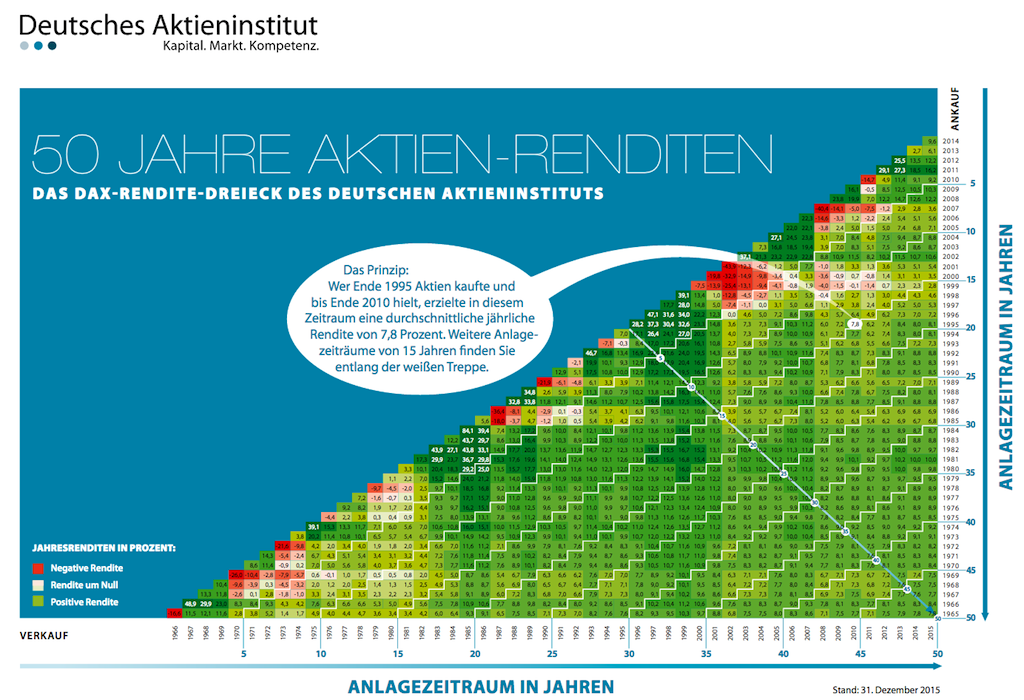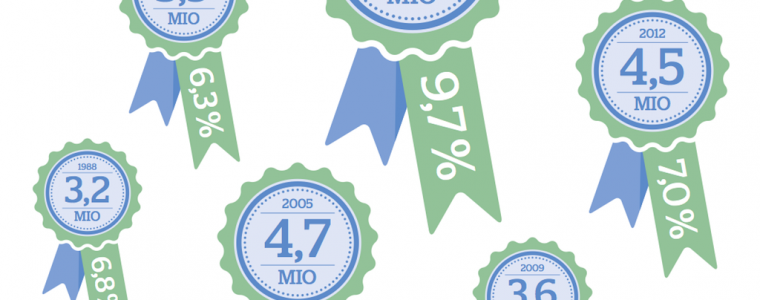DAX- und Eurostoxx-Rendite-Dreieck 2015
Das Renditedreieck mit den DAX-Renditen der letzten 50 Jahre zeigt die langfristige Entwicklung der Aktienanlage in deutsche Standardwerte. Das Renditedreieck für den Euroraum visualisiert die Renditeentwicklung des EURO STOXX 50 und damit der Standardaktien der Eurozone seit 1986.
Die Renditedreiecke des Deutschen Aktieninstituts (www.dai.de) untermauern unsere grundsätzliche Empfehlung für die Aktienanlage: Mit breiter Streuung und langfristigem Anlagehorizont bietet die Aktienanlage überlegene Renditechancen, und die Risiken kurzfristiger Kursschwankungen lassen sich beherrschen. Aktien oder Aktienfonds sollten aus unserer Sicht – natürlich in Abhängigkeit von der persönlichen Lebenssituation – ein fester Bestandteil der Vermögensbildung und Altersvorsorgestrategie sein.

50 Jahre Aktien-Renditen – Das DAX-Rendite-Dreieck des Deutschen Aktieninstituts (Dezember 2015)
Aktienrenditen in der Eurozone seit 1986 (31. Dezember 2015, auf Englisch)
Wie hoch war die durschnittliche 10jährige Rendite vom DAX? 112%
You probably don’t know, nor did we, so we have done the check.
The DAX started at 1000 points on 31 December 1987. It closed the year 2016 at 11481 points. That gives a compound average return of 8.8% per annum. Who is asking for more?
OK, we have also checked the annual performance in every single year since 1987. Here are the results, assuming that you would have hold the DAX for 10 years. This gives us a total of 20 investment periods (assuming that you would have invested on the 1 January of the period and sell on the 31 December at the period end).
FAZ: Die Vermögensfrage, Richtig in Aktien anlegen
Für die Altersvorsorge sind Aktien die ideale Anlageform. Trotzdem sind die Vorbehalte groß. Dabei muss eigentlich nur ein Grundsatz beachtet werden.
Der intelligente Sparer
Hallo! My name is Black Belt 001. I am one of the founder of the MyMoneyWorks platform.
I am an average guy. Averagely good looking, averagely smart, with an average job, and an average house. It’s good to be realistic – most people believe that they are above average, for example that „they drive better than the average driver“ (which is not the case: 90% of the population cannot be driving better than the average, statistically speaking).
So I am a normal guy. However, I believe that I have been a better investor than 90% of the German population in the last 10 years. And I guess that’s why you should continue reading.
Oh, and how do I know that?
Simple: less than 10% of Germans own shares, and I am one of them, and shares have performed pretty well over the period 2007-2016: +100% for my portfolio, with a mostly passive strategy (and I must admit: plenty of ups and downs). If I can do it, then anybody can do it. As long as you don’t make big mistakes, it is largely a ’no-brainer‘.
By the way, +100% over 10 years was no better nor no worse than the DAX, it was simply average, as I keep telling you! But I am happy being ‚average‘, when 10-year returns are +100%. If you don’t believe me, then read the 10 years of holding the DAX post, or check the 50 Jahre DAX-Rendite-Dreieck.
So I must have done better with my savings than the 90% of the Germans who left their money dormant. If you want to be above average yourself in the way that you manage your savings, then a good way to start is to read the ‚Faktbook Aktie‘ in our next post: Deutschland, das Land der Aktienmuffel. Enjoy!
FAZ: Investmentfonds sind die bessere Lebensversicherung
Fondsgebundene Lebensversicherungen verlieren jeden Vergleich mit ETF-Sparplänen. Ihre Kosten sind viel zu hoch. Außer in einem speziellen Fall.
Für die meisten Menschen macht ‚Riester‘ wenig Sinn, und ist eine schlechte Investition
Riester is a ’no brainer‘ investment. What can you lose? Nothing. What can you win? Nothing.
‚Riester‘ is a badly designed product. The intention was good, but the execution went wrong. If you like the idea of the state (politicians) and bank managers holding your hand, know that it comes at a cost. There is no free lunch.
- The fees: now, i.e. when you buy (typically 5%)
- The fees: during the saving phase
- The fees: when you retire (typically 1.5% of the capital, annually!)
- The lower tax now, but the tax later?
- The lack of control in the investment strategy (due to the capital paid-in being guaranteed….)
- The dismal performance so far, due to the assets being bought that bring no return
- The lack of control in investment strategy once you retire
Riester is great as there is no risk (capital is guaranteed). But the return will most likely be nil.
FAZ: Deutsche Angst kostet 200 Milliarden Euro
Die konservative Geldanlage hierzulande wird teuer bezahlt. Im Weltvermögensvergleich treten die Deutschen auf der Stelle. Andere sind im Sinkflug.
Bezüglich der Geldanlage ist kaum ein Volk so ängstlich wie die Deutschen. Nur in Österreich wird noch mehr Geld auf Bankkonten und noch weniger am Kapitalmarkt angelegt. Dies hat gerade im Niedrigzinsumfeld erhebliche Auswirkungen auf die Vermögensbildung.


